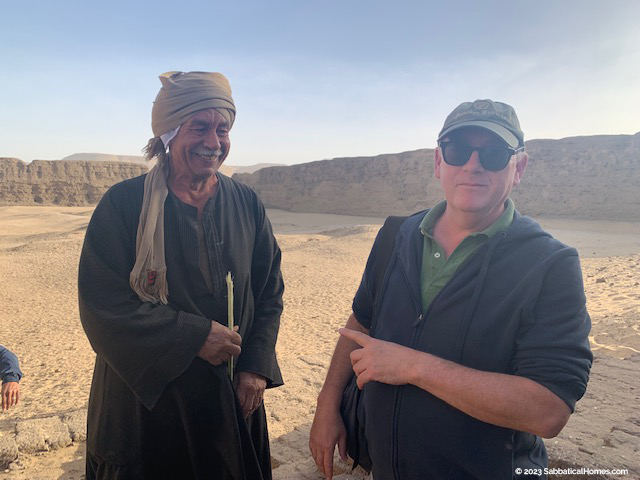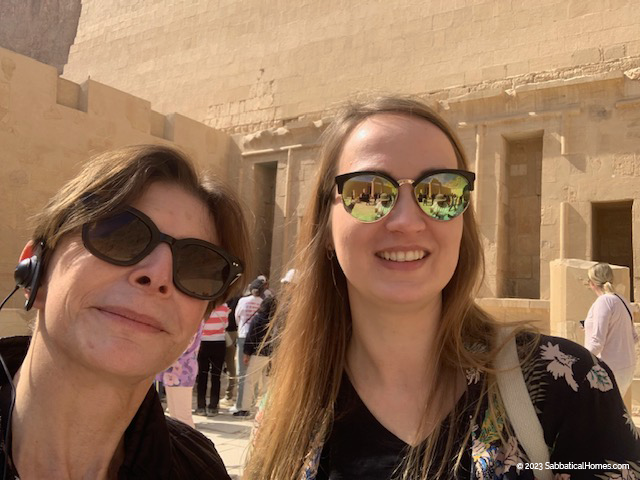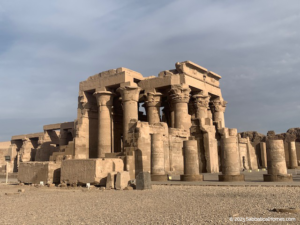SabbaticalHomes.com founder Nadege Conger recently had the opportunity to experience Egypt on a tour with the Archaeological Institute of America (AIA). It was truly a bucket list trip, a fascinating and educational immersion into part of our shared global history.
Seeing these landmarks in person was inspiring, in no small part because of the Egyptologists who make their life’s work researching, participating in digs, documenting, and sharing that knowledge with the rest of us. It is fair to say that these academics don’t live in the lap of luxury, often living for months at a time in hot and dusty conditions. Their insights and learning add incredible depth to our understanding of human history.
Traveling with the AIA also felt right, knowing that their tours help support important initiatives like professional archaeological fieldwork, educator training programs and various outreach and education programs. Join us on a virtual tour of some of the most striking sites this trip included!
Related: Learn more about the Archaeological Institute of America (AIA)
Meeting the Egyptologists
Stephen Harvey, Ph.D., was the primary lecturer traveling with the tour group. He shared his expertise throughout the trip, from Cairo to Abydos to Karnak, Luxor and the Valley of the Kings and Valley of the Queens. The tour ended by sailing the Nile River with a very special visit to Aswan prior to traveling back to Cairo. The tour group also had the privilege of meeting other Egyptologists working in the field as they traveled from place to place, specifically Katarzyna Kapiec, Ph.D. and Irene Forstner-Mueller, Ph.D.
Stephen Harvey, Ph.D., AIA Tour Lecturer and Egyptologist

came to say hello during an AIA Tour.
Lecturer Stephen Harvey’s profile on the Archaeological Institute of America website notes that he “has been Director of the Ahmose and Tetisheri Project, which centers on excavation of the monumental complex of King Ahmose at Abydos, under the aegis of the Pennsylvania-Yale-Institute of Fine Arts, NYU Expedition to Abydos. Steve’s fieldwork in and around the pyramid complex of Ahmose (ca. 1550-1525 B.C.) has provided important new insight into temple architecture and decoration at the outset of Egypt’s New Kingdom.”
Dr. Harvey has worked on many archaeological projects worldwide for over thirty years, he has been the lead lecturer on many tours in Egypt with the AIA and is also frequently consulted and interviewed for television documentaries produced by PBS, The History Channel and more.
In addition to his expertise in archaeology and in Egypt specifically, he has spent years studying Abydos. It was a rare treat to have such a specialist share their insights while at these sites. The following videos are examples of his lectures throughout the trip.
Related: Dr. Stephen Harvey’s Lecturer Profile on Archaeological Institute of America (AIA)
The Abydos Temple Paper Archive Project
In this video, Dr. Harvey discusses early 19th century documentation and papers of the original excavation of the Seti Temple that were recovered.
“Ayman [Damarany] and some others found a bunch of worm-eaten documents in the back of the Seti Temple where their predecessors in the 50’s and 60’s and so on had just bundled up a bunch of paper and dumped these things in the back of the temple, and they were about to be thrown out and burned. And these inspectors, young guys, were conscientious, so they started opening the bundles and realized they contained fascinating things going back to the early 19th century, archives of excavation maps, plans, drawings, letters – in Arabic, French, English, other languages – that document the history of digging in Abydos and elsewhere.”
Dr. Stephen Harvey, Ph.D.
The Fundamental Myth of Egyptian Religion: Osiris, Iris and Horus
Here, Dr. Harvey discusses the fundamental myth of Egpytian religion. In the video, he notes:
“This is a very important thing to tell you in terms of Seti Temple because why does Abydos matter? Because Osiris, one of the chief gods of the entire religion, was thought to be buried here, his head in particular. Remember he was cut apart and dismembered by his evil brother, Seth or “Set.” Seth is then defeated by Osiris’s son, Horus, who kills him. Isis, his wife (Osiris’s wife), gathers up the pieces of his body, puts him back, wraps him in linen and says magic phrases and he’s able to be brought back to life. She then decides, well I don’t have a son, so she has sex with the reinvigorated – shall we say – body of Osiris, which has been brought back to life in more ways than one. And we’ll see that scene and the child Horus is born to be the avenger of his father. So, this is the fundamental myth of Egyptian religion that you need to know about and it’s a fundamental myth of kingship because while living, the pharaoh is considered the living Horus, the avenger of his father, and when dead he becomes Osiris and is reborn.”
Dr. Stephen Harvey, Ph.D.
Valley of Kings: The Constellation Ceiling in Seti’s Tomb
Dr. Stephen Harvey, Egyptologist, shares his expertise on the Constellation Ceiling in Seti’s Tomb in Egypt:
“You can see how they would conceive of constellations, right? We would draw, maybe little stars, they used these red dots, and they configured the individual constellations differently than we would. So, for example, I pointed out the bull here, that whole bull here, is called Mesekhtiu and he was the Big Dipper. So, these are the circumpolar stars that do not change their location in the northern sky. What’s important about that the pharaoh, even in the pyramid texts, back in the old kingdom, now it’s the the new kingdom, so we’re now a thousand years later. The pharaohs are expressing the desire to join those stars since they don’t move location. They’re the “imperishable ones,” is what the Egyptians called them, the stars that don’t die. Because there’s this idea that stars will die, they disappear and then they reappear. Those don’t. It also has a scorpion goddess, Selqet, that means Scorpio, [like the astrological sign/constellation]. That’s Tawaret, the hippo goddess, she has a hippo head, a crocodile tail, a lion body and she’s pregnant with a crocodile on her back. [In our world, the constellation she represents is Drago, the dragon]. Now on these walls, the pharaohs with all sorts of fascinating symbolic aspects.”
– Dr. Stephen Harvey, Ph.D.
Katarzyna Kapiec, Ph.D. at the Temple of Hatshepsut, Deir el-Bahari
The group visited several archaeological sites in the West Bank of Luxor. One of these was the Temple of Hatshepsut, and here the group had the lucky opportunity to meet Katarzyna Kapiec, Ph.D. from the Institute of Mediterranean and Oriental Cultures at the Polish Academy of Sciences.
Even luckier, the day they visited this site was the first day the Southern Room of Amun – that Dr. Kapiec has spent many years researching – had ever been open to the public! We followed up later via email with some more detailed questions about her work.
A Conversation with Katarzyna Kapiec
SabbaticalHomes.com (SH):
How many years have you spent studying and documenting the decoration in the Main Sanctuary of Amun-Re, the Southern Room of Amun at the Upper Terrace of the Temple of Hatshepsut? How many years have you spent on the site itself?
Katarzyna Kapiec (KK):
I have been a member of the Polish-Egyptian Archaeological and Conservation Expedition to the Temple of Hatshepsut at Deir el-Bahari since 2010 (the expedition is currently directed by Dr. Patryk Chudzik and affiliated with the Polish Centre of Mediterranean Archaeology, University of Warsaw). At first, I was an illustrator in a side project dedicated to the documentation and reconstruction of the temple of Thutmose I. I’m still in this project, now responsible for publishing the offering scenes from the offering chapel.
In late 2014, I started my work in the Southern Room of Amun. In 2014-2019, I completed the documentation of the room – drawings of the whole decoration as well as the coronation scene above the entrance to the room. (The fieldwork as well as the study was funded with a grant from a National Science Centre in Poland, affiliated with the Institute of Mediterranean and Oriental Cultures at the Polish Academy of Sciences, where I’ve been employed since 2016.)
In late 2021, I published the first part of the study on the Southern Room of Amun and in January 2023, I defended my Ph.D. thesis ‘The Southern Room of Amun in the Temple of Hatshepsut at Deir el-Bahari. Its Decoration and Ritual Function in the Upper Courtyard Complex’ at the University of Warsaw. I was awarded a distinction for my thesis. The second part of my study, which is the interpretation of the function of the Southern Room of Amun, is going to be published next year.
Related: Katarzyna Kapiec, Ph.D. Academia.edu
Irene Forstner-Mueller, Ph.D. at Kom Ombo

Another fascinating stop on the tour was at Kom Ombo, where they had the good fortune to meet Dr. Irene Forstner-Mueller, of the OeAI Cairo Branch of the Austrian Archaeological Institute (part of the Austrian Academy of Sciences).
Dr. Forstner-Mueller is the lead researcher on the site, her team has been working there since 2017. Located on the banks of the Nile River, “the site of Kom Ombo has been settled since the prehistoric period to the 19th century CE. In the Greco-Roman period Kom Ombo was the metropolis and capital of the first Upper Egyptian Nome. Starting in November 2017, research on this important city and its hinterland will be conducted by the Cairo Branch.” (source: “Kom Ombo: City and Hinterland” www.oeaw.ac.at).
In 2018, along with Nadine Moeller, she published The Hyksos ruler Khayan and the early Second Intermediate Period in Egypt: Problems and Priorities of Current Research, and she will be publishing The Town of Kom Ombo Volume I later this year as well.
Related: Kom Ombo: City and Hinterland Archaelogical Research
Sailing the Nile River in Egypt
For the last several days of the trip, the group traveled together down the Nile River on two traditional Nile sail boats called dahabiyas, a unique experience in itself. Add to that the wonderful archaeological sites, museums and cultural experiences – and the sunsets and water buffaloes – for a truly magical ending to the tour.
Experiencing Egypt with Academics
We are grateful to the lecturers and researchers who took the time to share their expertise and passion with the tour group. Having the opportunity to learn from these archaeologists and about the history they painstakingly excavate and analyze for posterity was an invaluable experience.
Spending time with academics and scholars of all specialties always makes us proud to provide SabbaticalHomes.com as a resource for our community of Minds on the Move. Founder Nadege Conger started the website in 2000 because her academic family struggled to find reasonable, temporary housing when traveling abroad for scholarly work. It is an honor to continue providing this service to this day, and we welcome new members as well as our longtime loyal members who regularly recommend our website to their own academic networks!
Related: Getting Started with SabbaticalHomes.com
Let us know what you think! Connect with us on Twitter, LinkedIn, Facebook, Instagram, YouTube and Pinterest.





